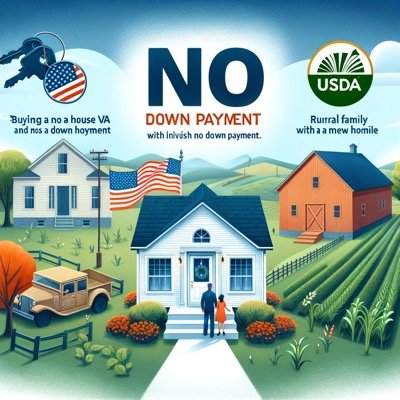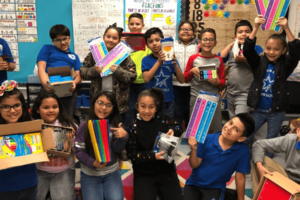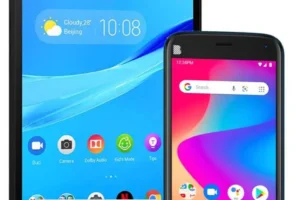How to buy a house without Down Payment

Buying a home represents one of the most significant milestones in many people’s lives, but the down payment requirement can be a considerable obstacle. However, there are ways to purchase a home without this down payment, opening the door to home ownership for those who cannot afford a large down payment.
In this article, we will explore various strategies and programs that make it easier to buy a home with no down payment, offering alternatives even for those with less-than-favorable credit scores.
The Reality of No Money Down Mortgages
Contrary to popular belief that substantial savings are essential to purchase a home, there are options for those looking to escape renting and make the leap to homeownership without having to make a down payment.
These options are presented primarily through government-backed loans designed to help different population groups achieve their American dream.
VA and USDA Loans: A Path to Ownership
VA (Veterans Affairs) and USDA (United States Department of Agriculture) loans represent two of the most attractive options for those interested in purchasing a home with no down payment, providing unique opportunities for veterans, service members, and buyers in eligible rural areas.
Here we delve into how these programs facilitate the path to homeownership, highlighting their benefits and requirements.
VA Loans: Support for Veterans and Service Members
VA loans are designed specifically for veterans, active duty service members, reservists, and certain surviving spouses, offering them the ability to purchase a home without requiring a down payment. This program not only facilitates the acquisition of a home without the need for significant initial savings, but also offers several additional advantages:
- Competitive interest rates: VA loans generally have lower interest rates compared to conventional mortgages, resulting in lower monthly payments.
- No private mortgage insurance (PMI) required: Unlike many conventional mortgages with less than 20% down payment, VA loans do not require PMI, which can save buyers hundreds of dollars a month.
- Flexible credit requirements: Although lenders have their own guidelines, VA loans are generally accessible with lower credit scores compared to traditional mortgage loans.
- Limitations on closing costs: The VA limits the closing costs that veterans must pay, and some costs may even be covered by the seller.
USDA Loans: Housing Development in Rural Areas
USDA loans are intended to assist homebuyers in rural and certain suburban areas. Like VA loans, they offer the opportunity to purchase a home with no down payment, along with other advantages:
- 100% financing: USDA loans allow you to finance the entire purchase price of the home, eliminating the need for a down payment.
- Competitive interest rates: USDA loans often offer low interest rates that can make homeownership more affordable.
- Flexible credit requirements: Although applicants must have a reasonably good credit history, credit requirements are generally less stringent than those for conventional loans.
- USDA loan guarantee: This backing reduces risk for lenders, which can result in better terms for the buyer.
How to Qualify
- For VA loans: Applicants must meet the service requirements specified by the Department of Veterans Affairs, which include active duty for certain periods or honorably discharged veteran status. Surviving spouses of military members who died in service or due to a related disability may also be eligible.
- For USDA loans: Buyers must choose a home in an area designated as rural by the USDA, not exceed the income limits established for the specific region, and demonstrate an ability to repay. In addition, the dwelling must be used as a primary residence.
VA and USDA loans offer valuable pathways to homeownership for those who qualify, eliminating the financial hurdle of a down payment and providing advantageous loan terms.
For many, these programs can mean the difference between renting and owning a home, offering a tangible opportunity to achieve the American dream of homeownership.
Alternatives for Low Down Payments
Low down payment alternatives are essential for buyers who do not meet the criteria for VA or USDA loans but still want to purchase a home without a large down payment.
Here we present some of these alternatives, highlighting how they work and who can benefit from them:
1. FHA (Federal Housing Administration) Loans
- Description: FHA loans are designed for low to moderate income buyers who may not qualify for conventional loans. They are backed by the federal government and offered through FHA-approved lenders.
- Down payment: As low as 3.5% of the purchase price of the home.
- Benefits: Less stringent in terms of credit scores; allow down payment to come from a gift or grant.
- Ideal for: First time buyers, buyers with less than perfect credit, or those with low to moderate income.
2. Conventional Loans with Low PMI
- Description: Loans offered by private lenders with no government guarantee. They often require PMI (private mortgage insurance) if the down payment is less than 20%.
- Down payment: Can be as low as 3% for first-time homebuyers.
- Benefits: Flexibility in the choice of lender and the possibility of eliminating PMI once 20% home equity is reached.
- Ideal for: Buyers with good credit scores who can afford slightly higher monthly payments due to PMI.
3. HomeReady® and Home Possible® Programs
- Description: Programs offered by Fannie Mae and Freddie Mac, respectively, designed for low to moderate income buyers.
- Down payment: As low as 3% and possibility to finance PMI, which reduces monthly costs.
- Benefits: Flexible income requirements, and income from rents and household members are considered to qualify.
- Ideal for: Buyers with low to moderate incomes, including multi-generational families or buyers with additional tenant income.
4. Down Payment Assistance Programs
- Description: Many states and localities offer down payment assistance programs for first-time or low-income homebuyers.
- Down payment: Assistance that can cover the full cost of the down payment or provide low-interest loans for the down payment.
- Benefits: Facilitates the purchase of a home without the need for significant savings.
- Ideal for: Buyers who qualify for mortgage loans but do not have the funds for a down payment.
5. Piggyback Loans
- Description: A combination of loans where the buyer obtains a primary mortgage loan for 80% of the price of the home, plus a second loan (such as a home equity line of credit) to cover the down payment.
- Down payment: 0% of the purchase price, using the second loan to cover this cost.
- Benefits: Avoids PMI and allows you to purchase a home with no down payment.
- Ideal for: Buyers with good credit and financial stability looking to avoid PMI but do not have savings for a down payment.
These alternatives offer flexibility and options for a variety of financial situations, allowing more people to access homeownership without the need for large initial savings.
Strategies for Managing Low Credit
An additional challenge facing many aspiring homeowners is a low credit score.
However, there are strategies to manage this situation, such as improving your credit score before applying for a loan and exploring loans that offer flexibility in terms of credit requirements. These actions can improve the chances of qualifying for a mortgage with favorable terms.
The Importance of Financial Advice
Before making the decision to buy a home with no down payment, it is crucial to obtain financial advice. Fully understanding the loan terms, interest rates, and how the absence of a down payment can affect monthly payments and the total cost of the loan is essential to making an informed decision.
The ability to purchase a home without a down payment opens the door to homeownership for a broader segment of the population.
Through VA and USDA loans, as well as other low down payment alternatives and strategies for managing low credit, it is possible to achieve the dream of homeownership. However, it is vital to proceed with care, be properly informed and seek financial advice to ensure that the decision you make is the right one for your financial situation.






